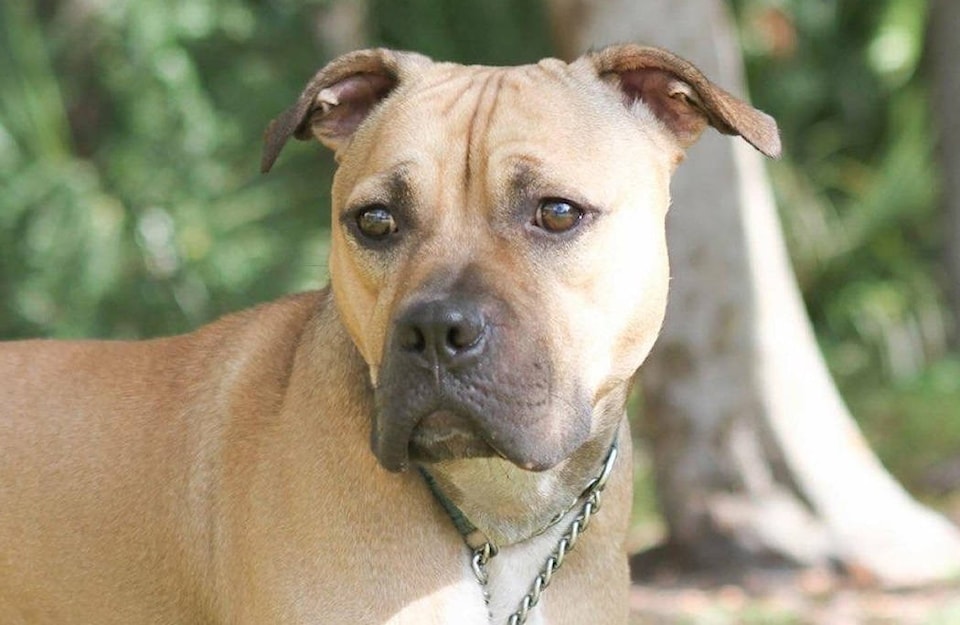Dallas’s ear-to-ear grin and bright brown eyes seem to sparkle with joy.
The 3-year-old pit-bull-type dog’s radiance makes it difficult to believe he was once a member of a fighting ring and later the subject of multiple court battles, narrowly escaping a death sentence.
Now Dallas’s demeanor is leading him to a new chapter in life: He is among the first pit bulls ever rescued from fighting to train as a police K-9. Next month, after about six weeks of training to sniff out narcotics, he is set to join the force in the southwest Virginia town of Honaker.
His love for balls was key, said Jen Deane, founder and president of Pit Sisters, a Florida rescue group: “We knew that his combination of ball drive and his wanting of human praise was the perfect combination to be a police dog.”
That would have been hard to predict in 2015, when police and agents from the Ontario Society for the Prevention of Cruelty to Animals seized Dallas, then a puppy, and 30 other pit bulls from a compound in the Canadian province.
According to court documents described by Canadian news media, the dogs were chained to metal stakes in the ground, and evidence of fight training - including schedules, muzzles, sticks, steroids and suture kits - was found on the property. An inspector noted “severe scarring consistent with dog fighting,” the Globe and Mail reported.
Five people were charged with weapons and animal cruelty violations, as well as with breaking an Ontario ban on pit bulls.
Rob Scheinberg, the co-founder of a rescue and sanctuary in Ontario called Dog Tales, said that when he read news accounts of the raid, he knew he wanted to save as many of the seized dogs as possible.
“I thought, ‘There is no way there are not a few good dogs,’ ” Scheinberg said.
Soon he had hired a lawyer, and for two years he waged a court battle in protest of an OSPCA application to euthanize 21 of the dogs, including Dallas, based on a behavioral assessment that deemed them dangerous. By this spring, celebrities had gotten involved, and #Savethe21 was circulating on social media.
After various twists and turns, the court eventually ordered the dogs’ owner to surrender 18 of the animals for rehabilitation; two others died in OSPCA custody, and a third was deemed dangerous and ordered to be euthanized, local media reported. It helped that Dog Tales had pledged to pay for the care of the animals and their transport out of Ontario, where a pit bull ban made their presence illegal.
“We were relentless,” Scheinberg said of the court fight. “They knew we were not going to stop.”
All 18 dogs were sent to rescues or were adopted, and Pit Sisters took in 10. Dallas was enrolled in the group’s program that matches hard-to-adopt dogs with prison inmates, who socialize, train and care for the canines.
“When Dallas arrived, he was always alert and attentive to everything and everyone. He would stay standing in his kennel looking around his surroundings and wag his tail when someone would walk by,” Nicholas Ramos, an inmate who worked with the dog at Lawtey Correctional Institution, southwest of Jacksonville, said in an email. “He loved attention and was very affectionate toward people.”
Deane said it didn’t take long for her and the prison program’s administrators to decide that Dallas would be a great K-9. But K-9 training is expensive and intense.
Enter Carol Skaziak, founder and chief executive of a Pennsylvania nonprofit group called the Throw Away Dogs Project, which says it seeks to “repurpose unique dogs.” Some go on to be adopted by families, she said, while others have become service dogs for veterans and children with disabilities.
After Deane contacted Skaziak and sent her videos of Dallas in action, Skaziak and a police K-9 trainer her group works with, Bruce Myers, traveled to Florida to assess him.
“We knew almost right away that we had to do this,” Skaziak said.
Myers, an 18-year veteran of training police dogs, is working with Dallas in as many as three daily sessions aimed at teaching him to sniff out narcotics.
“He will save many lives,” Myers said. “If he helps take one brick of heroin off the street, that can save 1,000 people. And he will be incredibly proficient by the time he leaves here.”
Hundreds of miles south in Virginia, Honaker police are preparing to welcome the soon-to-be K-9 narcotics officer. They had long wanted such a member on the force, Police Chief Brandon Cassell said, but the town of about 1,500 couldn’t spend the $10,000-plus needed for such a highly trained dog. Pet Tales, the Canadian rescue group, covered the training costs and is donating Dallas to the department.
“We are going to treat him just like a regular officer,” said Cassell, who added that he has no concerns about having a pit-bull-type dog, even one born into a fighting ring, on staff. “We know what he is going to wear, have ordered him a badge and are going to welcome him to the department just like we would a human officer.”
When Dallas finishes training, he’ll live and work with Honaker police officer Cody Rowe. A former K-9 officer with the Virginia Department of Correction, he lobbied to establish a K-9 program in the police department.
“I worked with a lot of German shepherds, but I remember many handlers worked with pit bulls,” Rowe said. “They are incredible police dogs… . It’s amazing to watch them work.”
Myers, the Pennsylvania trainer working with Dallas, said that shouldn’t surprise anyone.
“Pit bulls are misunderstood because many are improperly trained,” Myers said. “Dogs aren’t born vicious. We make them vicious. Don’t blame the dog. Blame us.”
